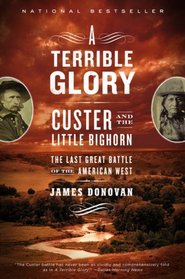I was a bit disappointed in this book, which I purchased after visiting the Custer Battlefield National Monument (highly recommended, by the way). There were, of course, dozens of books on offer there, and the docent who led our tour group there recommended this one. One of the selling points was that Donovan was the first author to have access to the results of a 1984 forensic archaeological dig allowed on the battle site and which supposedly shed new light on details.
If such âdetailsâ were utilized in the book, they weren't obvious. In fact, despite devoting a whopping 400 pages (plus extensive footnotes) to the buildup to and aftermath of the event, the section of the narrative on the battle itself is confusing and inconclusive. Much more ink is devoted to the actions of Major Marcus Reno and Captain Frederick Benteen, whose mutual failure to follow the battle plans sketched out by Custer played a large part in the Seventh Cavalry's devastating loss. In a way, this may be excused â there were many survivors in the Reno and Benteen camp whose testimony painted a clear picture of both groups' actions, while the lack of survivors among Custer's contingent made firsthand testimony impossible. Native American testimony, however, has long been available and one wishes more use had been made of those sources.
Donovan does paint a broad canvas, however, and effectively places Custer's campaign within the larger picture of American incursion into Native American lands. That may be the book's greatest value to the amateur historian. The Battle at the Little Bighorn, and indeed the entire post-Civil War era of the Indian wars, did not occur in a vacuum, and Donovan evokes the era and its players with style.
If such âdetailsâ were utilized in the book, they weren't obvious. In fact, despite devoting a whopping 400 pages (plus extensive footnotes) to the buildup to and aftermath of the event, the section of the narrative on the battle itself is confusing and inconclusive. Much more ink is devoted to the actions of Major Marcus Reno and Captain Frederick Benteen, whose mutual failure to follow the battle plans sketched out by Custer played a large part in the Seventh Cavalry's devastating loss. In a way, this may be excused â there were many survivors in the Reno and Benteen camp whose testimony painted a clear picture of both groups' actions, while the lack of survivors among Custer's contingent made firsthand testimony impossible. Native American testimony, however, has long been available and one wishes more use had been made of those sources.
Donovan does paint a broad canvas, however, and effectively places Custer's campaign within the larger picture of American incursion into Native American lands. That may be the book's greatest value to the amateur historian. The Battle at the Little Bighorn, and indeed the entire post-Civil War era of the Indian wars, did not occur in a vacuum, and Donovan evokes the era and its players with style.
Leo T. reviewed A Terrible Glory: Custer and the Little Bighorn - the Last Great Battle of the American West on + 1775 more book reviews
"More than anything, the Indians all agreed later, the battle resembled a buffalo chase (243)."
A very detailed history, including even the nicknames of various companies of the 7th, such as "Band Biox Troop," Gray Horse Troop." The actual regimental commander, Col. Sturgis, was TDY but many Custer associates ("the Custer clan") were present. The photo plates include many of the LTs, and the Indians look fierce even in a formal portrait. Excellent map, with insets, by J.L. Ward that includes the location of major battle sites 1864-1890.
Despite the present day people who feel Indians are dishonored by being recalled by sports teams, those who fought them from the 17th-19th C. well knew how tough and worthy of respect they were. I am reminded of the second Pt. Bush's wars: "An enemy that could not be caught and would not stand still(57)."
Donovan relies on eyewitness accounts, taking into consideration when recorded (fading memories?) and possible motivations of the witness (an axe to grind?). He emphasizes no one knows what happened after Custer dispatches trumpeter John Marin with a message. The 210 deaths were described only by "sketchy and contradictory" Indian accounts.
The endnotes are of interest and vital if one wants to track down a source. As the bibliography shows, many obscure publications were unearthed. The index appears copious but when I tested it with John Martin (above), there was no entry.
A very detailed history, including even the nicknames of various companies of the 7th, such as "Band Biox Troop," Gray Horse Troop." The actual regimental commander, Col. Sturgis, was TDY but many Custer associates ("the Custer clan") were present. The photo plates include many of the LTs, and the Indians look fierce even in a formal portrait. Excellent map, with insets, by J.L. Ward that includes the location of major battle sites 1864-1890.
Despite the present day people who feel Indians are dishonored by being recalled by sports teams, those who fought them from the 17th-19th C. well knew how tough and worthy of respect they were. I am reminded of the second Pt. Bush's wars: "An enemy that could not be caught and would not stand still(57)."
Donovan relies on eyewitness accounts, taking into consideration when recorded (fading memories?) and possible motivations of the witness (an axe to grind?). He emphasizes no one knows what happened after Custer dispatches trumpeter John Marin with a message. The 210 deaths were described only by "sketchy and contradictory" Indian accounts.
The endnotes are of interest and vital if one wants to track down a source. As the bibliography shows, many obscure publications were unearthed. The index appears copious but when I tested it with John Martin (above), there was no entry.




